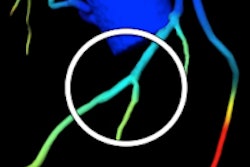Thursday, December 5 | 11:30 a.m.-11:40 a.m. | SSQ03-07 | Room S504AB
This scientific session will discuss a study in which fractional flow reserve CT (FFR-CT) yielded similar discrimination and accuracy to invasive FFR for diagnosing lesion-specific ischemia across a variety of patients.Invasive FFR in conjunction with angiography is the gold standard for determining lesion-specific ischemia. FFR-CT, the noninvasive CT version of FFR, works well, but its accuracy had not been studied in different demographic groups.
The Determination of Fractional Flow Reserve by Anatomic CT Angiography (DeFACTO) study was the first large-scale, international, multicenter study to evaluate the feasibility of applying computational fluid dynamics to coronary CT angiography to determine rest and hyperemic coronary pressure and velocity, Dr. James Min from NewYork-Presbyterian/Weill Cornell Medical Center told AuntMinnie.com.
"When clinically applied, this technology will enable pinpointing of specific coronary artery lesions that cause ischemia in a noninvasive fashion by the calculation of FFR, a technique that has been shown in large-scale, randomized, controlled trials to guide percutaneous interventions for improved event-free survival," Min said.
FFR-CT found ischemia in about one-third of vessels, showing similar per-patient discrimination for younger versus older subjects and men versus women, affirming its value in cardiac workup with coronary CT angiography, the study team reported.




















